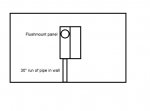Yes, for the last scenario you posted. The service conductors are underground, outside the building, and then terminate in in a panel that is is the first reasonable readily accessible point.
No problem. Does not have to be an exterior wall as long as it is a straight shot from underground to panel.
"first reasonable readily accessible point" This is what I'm getting at. Reasonable. The code doesn't say reasonable, but everyone understands that it's implied and necessary.
So in my situation, if the utility demands my mast be in one location and the NEC demands my disco be in another location 4' away horizontally then how does it not still qualify as being "first reasonable readily accessible point"? Moving the disco any closer to the mast violated clearances the NEC mandates for the disco.


